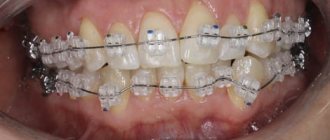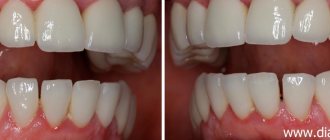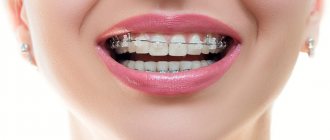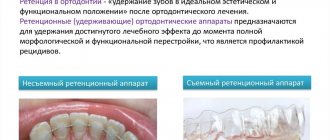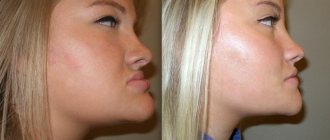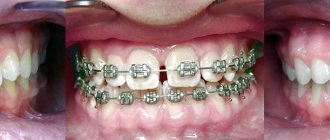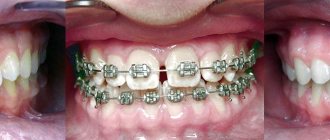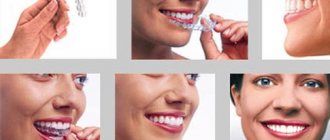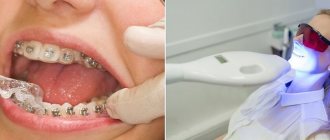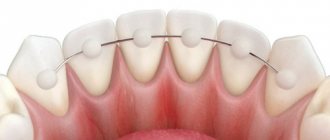This is a headache and a nightmare for any orthodontist: a patient who has had his braces removed and given a removable retainer and instructions for its use returns after some time with complaints about the curvature of his previously straight teeth. The retention period is the most psychologically difficult part of the treatment. Everything is already perfect, and then you have to wear a retainer. Yes, there are other reasons for the unsuccessful outcome of the correction. And although they are much less common, let’s talk about them in more detail.
Correction principle
The method of correcting malocclusion with braces is based on the principle of creating constant pressure on the teeth. Under pressure, the tooth root begins to press on the socket on one side, thereby causing rarefaction of the bone tissue. In the direction of rarefaction, the tooth moves. On the other side of the hole, bone tissue, on the contrary, grows. Thus, after a certain period of time, not only the position of the tooth changes, but also the shape of the socket, which prevents the tooth from returning to its original place.
Correct your bite or dental defect with invisible aligners Find out what it is
Bone tissue grows quite quickly, but it takes quite a long time to “ripen”. That is why, after finishing wearing the brace system, a removable retainer is made for the patient for another year or two or a splint is installed on the incisors and canines. Additional fixation during the retention period helps to avoid repeated tooth curvature.
How much does it cost to tighten braces?
Cost of braces tightening
depends on the type of bracket system, the total complexity and cost of the work. For non-ligature braces, you may need to replace the arch, for ligature braces, you may need to replace the ligature; in any case, these are additional materials.
This issue should be discussed with your orthodontist in advance. In some cases, the price of braces tightening is included in the overall contract for orthodontic treatment. On average, the cost of braces tightening in St. Petersburg
varies from 1800 to 3000 rubles.
Sign up for a consultation at As-Stom dentistry
or for the procedure for activating the braces you wear, you can call
597-05-05
or use
the online application form
.
Possible problems after removing braces
Some people's teeth diverge quickly after completing the correction stage. During the first year, some individuals may only slightly rotate around their axis. Everything is individual, but some general patterns can be identified.
Fanned teeth
A rapid relapse after braces are removed may be due to the following factors:
- Refusal of retainers. Patients often refuse permanent retainers because their installation damages tooth enamel. And it’s annoying to wear removable retainers, even those that are worn only at night. As a result, the teeth return to their previous position, since the new position has not yet been “overgrown” with bone tissue.
- Individual characteristics. There are people in whom new formation and “maturation” of bone tissue proceeds faster than others. And there are those for whom this process is delayed. For some, the displacement of teeth in order to correct the shape of the dentition was insignificant, while for others the tooth “came a long way” before taking its place in the dentition. Teeth quickly “huddle together” after crowding is eliminated. The teeth, which were mixed with braces around their axis, easily turn back.
- Breakage of braces, use of a system of inadequate quality. If the pressure on the teeth during correction was not constant, then the likelihood of an unfavorable outcome increases. You shouldn’t walk around with a broken arch or unstuck locks for a week. It is better to see a doctor on the same day. This will save you from many problems.
- Tooth extraction. When there is not enough space for teeth in the dentition, the orthodontist may decide to remove the “extra” ones. Most often these are fours, eights, less often sixes. The absence of fangs can cause the formation of a diastema. Removing a six causes significant displacement of adjacent teeth.
Loose teeth after braces
Occurs infrequently. In most cases, the feeling of excessive tooth mobility after removing braces is deceptive. It may appear at the very beginning of the retention period and disappear on its own and without treatment. It's another matter if the teeth are really loose. In this case, it is better to seek help from a specialist.
Pain in the teeth and gums
There may be some discomfort after removing braces. Pain occurs especially often after eating solid foods. The reason for this is a change in the condition of the ligaments that hold the roots of the teeth, as well as an increase in the sensitivity of the enamel if the remineralization procedure was not carried out. Reducing the chewing load and using special medications that reduce the sensitivity of teeth and gums help reduce pain.
When should I expect pain to appear?
Before you decide to create a beautiful and attractive smile with the help of braces, you should learn more about this technology. It is carried out in stages.
- First of all, preparatory work is carried out. They include the treatment of dental caries and the removal of plaque from their surface. This is done in order to eliminate all problems associated with the integrity of tooth enamel and minimize the risks of gum disease. After all, braces are installed for a very long period, which can even be several years.
- Next, the bracket system is customized for each person individually, based on the shape and size of their jaws.
- The treating dentist fixes the breaker element on each tooth using special glue, after which all their clasps are connected to the arches of the bracket system. In this case, no pain should occur, since the work is carried out only on the surface of the teeth. Of course, the patient feels some discomfort due to a foreign object appearing in the mouth.
It should also be understood that the presence of a braces system in the oral cavity, attached to the teeth, requires special hygiene procedures and rules for eating, as well as following a certain diet. This is especially true for the most common version of braces – a permanent structure.
The work of the braces system consists of targeted pressure on a number of teeth through special arches. The strength and direction of this impact is adjusted by the doctor, using special screws, rubber rods or wire arches, depending on the design features of the braces. It is for this reason that teeth hurt when wearing braces for the first time after installation or a session of correcting their position.
Painful sensations in most cases directly depend on the force of pressure of the braces on the teeth. A highly qualified specialist with successful experience very accurately calculates the level of force so that the teeth are moved not only effectively, but also as painlessly as possible.
But even the most experienced doctor can cause pain with his actions. This happens when a person has a very low pain threshold. The patient must immediately inform his dentist about this. Based on this statement, the treatment schedule will be revised, the pressure of the adjustment screws will be reduced, and certain pain medications will be prescribed to reduce the pain from braces.
The patient often experiences pain after replacing the arches, but, as practice shows, it is quite mild and goes away quickly. Otherwise, you should immediately contact your doctor to resolve this problem.
How long do your teeth hurt after getting braces?
If your teeth or gums start to hurt after you got braces, don’t worry too much. Surely your doctor warned you that there may be pain at first.
Such unpleasant and painful sensations immediately after the installation of these orthodontic structures is completed is a completely natural phenomenon. Depending on the individual characteristics of the body, pain can be of varying degrees; there were practically no cases when the patient was able to avoid it.
Most importantly, you should not immediately blame the attending physician for the appearance of pain and discomfort, claiming that he installed the braces incorrectly and worked negligently. This is absolutely not true.
- First, each person has a different perception of pain and a certain level of patience to ignore it for a while.
- Secondly, it is easier to endure pain when you understand what caused it. To straighten the dentition, a certain amount of pressure is applied to each tooth. This, in turn, causes loosening of the row element with subsequent build-up of bone tissue. This whole process causes not only severe discomfort, but also quite severe pain. This adjustment period can last from several days to one or two weeks.
To minimize your suffering, you should visit your dentist so that he can prescribe the most effective painkillers for you.
After a certain time after taking these medications, the pain goes away, and the teeth, accustomed to the stress of the braces system, will not cause any discomfort in the future.
Recommendations on how to relieve pain from braces
To make the feeling of discomfort and pain due to such a foreign structure in the oral cavity as a brace system go away faster and easier, you should pay attention to the following tips:
- If severe pain occurs during the first time after installing braces, you should take painkillers strictly as prescribed by your doctor. As a rule, medications are taken after meals.
- If the design of the brace system irritates the oral mucosa, it is recommended to stick orthodontic wax on its surface. After three to four days, after you have gotten used to the braces, you don’t have to use wax.
- You can get rid of pain quite successfully by simply rinsing your mouth with salted water or other similar solutions. It is advisable to carry out this procedure several times throughout the day.
- If damage to the mucous membrane has occurred and a wound has formed on the oral cavity, then it is necessary to immediately apply medications that promote wound healing and relieve pain.
After installing braces, you should pay close attention to the range of products that are included in your daily diet. You should definitely avoid chewing gum and seeds, fresh carrots and green apples, hard cheese and sausages, as well as other products that can clog and clog the space between the tooth enamel and the brace system structure.
It would be optimal to stick to a diet with light first courses, various cereals, steamed vegetables and meat while wearing braces. Today you can find many delicious dishes, the recipes of which are perfect for people with installed braces.
addictive
The first thing the patient encounters is discomfort or even pain from braces. Unpleasant sensations and pressure on the jaw can bother you after each visit to the orthodontist, when you need to change the arches (every 1-2 months), or they can stop after a week of wearing and never return. In any case, you should be patient:
- getting used to braces usually takes from 3 days to 2 weeks;
- if they injure the cheek mucosa, use special wax or silicone;
- There’s no need to worry about poor diction—correct speech will return as you get used to it.
If you have severe pain and have any questions about how to live with braces, call your orthodontist. He will reassure you or invite you to an appointment to check the system again.
Care
To understand how to live with braces and maintain healthy teeth, you will need to learn again, in a completely different way (the doctor will tell you how exactly) to brush your teeth and generally care for your oral cavity. If the doctor sees that your hygiene skills are insufficient, he may insist on stopping treatment early - the risk of developing caries increases tenfold.
For complete self-care of your teeth and braces, you may need:
- orthodontic and monobeam brushes,
- brushes of different diameters and types, cylindrical, cone-shaped, curved,
- special dental floss (floss),
- several types of toothpastes, mineralization gels, rinses,
- An irrigator is the most convenient tool for cleaning hard-to-reach places.
Teeth with braces should be brushed and rinsed after every meal. Of course, do not forget about professional hygiene - regularly, once every six months.
Nutrition
During the period of adaptation, soft or liquid food is necessary. Difficulties will arise with large and hard pieces, nuts, sweets, and crackers. Many products will have to be ground in a blender. It is also worth avoiding too cold or hot foods - at first the sensitivity of the enamel and gums increases.
Life after getting braces is a menu consisting mainly of foods and dishes that are easy to chew, convenient to bite, and after eating you can quickly brush your teeth:
- fermented milk drinks (kefir, fermented baked milk, yogurt);
- porridge from semolina, wheat, buckwheat, oatmeal, rice;
- meat pate;
- jams;
- puree soups;
- jellies and curd mousses;
- bananas, plums, watermelons, apricots and persimmons.
After adaptation, this list can be expanded, but it is still worth excluding from the diet:
- anything sticky that easily gets stuck in braces and becomes food for bacteria - nougat, toffee, chewing gum, caramel, etc.;
- starch in baked goods, cereals, and corn sticks, which also remains in the mouth.
